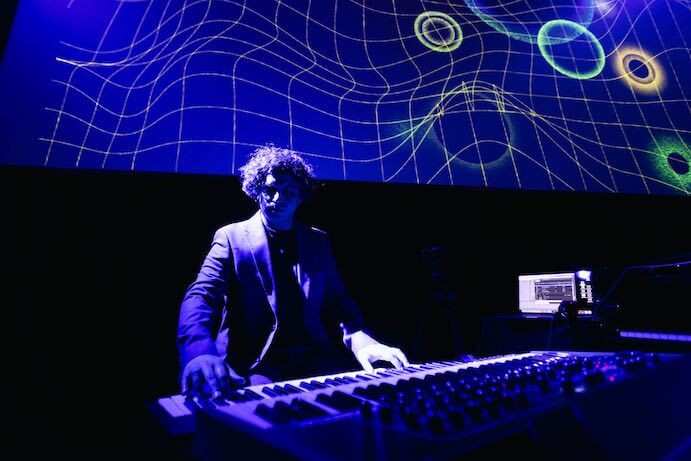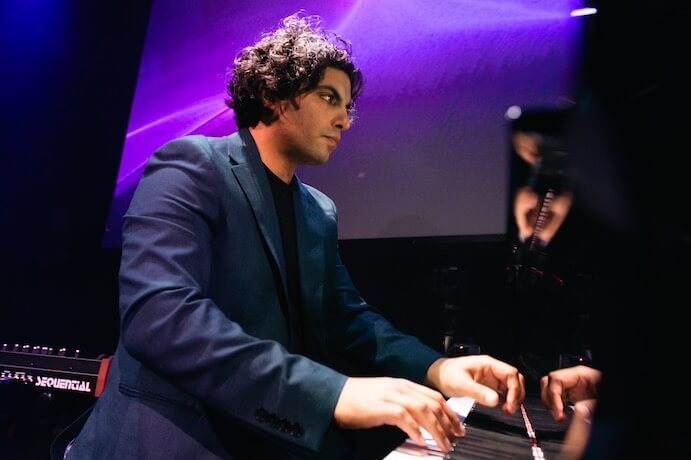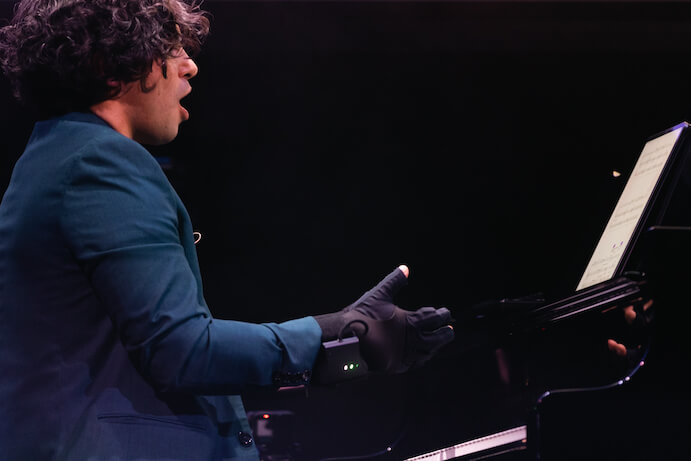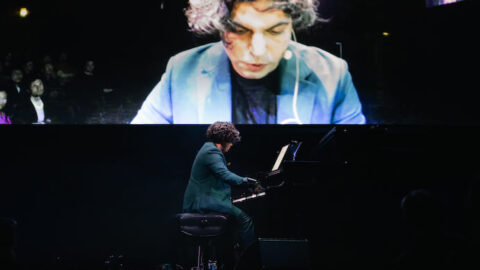The Australian-born pianist and composer Zubin Kanga’s current research project, Cyborg Soloists, explores technology-driven keyboard music. A stunning piano virtuoso, he also uses multiple types of keyboards, capable of playing microtones and seamless glissandi, plus new forms of instrument interaction, including wearables. His Sept. 30 concert at Kings Place, in London, launched his new album and featured four world premieres and two pieces he premiered last year; most are based on reimagining standard piano figuration or music of the past.
The concert opened with Oliver Leith’s Vicentino, love you – studies for keyboard, a set of short pieces for microtonally-inflected keyboard, with skewed, squishy chord progressions and occasional unexpected rhythmic irregularity. Sometimes these studies sounded like a contemporary Satie, simple yet profound. Leith seems to have precisely located the musical point where sweet merges with sour.

Emily Howard’s DEVIANCE for piano and electronics is a collaboration between Howard, Bofan Ma (sound design) and visual artist Erik Natanael Gustafsson, all of whom were inspired by images based on brain data of people listening to Howard’s music. The captivating visuals, mostly red/blue/purple and swirling like a luminous undersea creature, were layered over a wide-ranging disjunct piano part that rotated around a few ideas and recorded effects. I couldn’t help wondering what a visualisation of the Kings Place audience’s brain data would look like.
The music of Shiva Feshareki is based on simple yet compelling ideas. Whirling Dervishes, for piano and turntables/immersive electronics, is an exhilarating piece that seamlessly moves from one section to another as if mixed by an expert DJ. Kanga began gently with single detached notes descending the keyboard, though the music built up to a couple of rippling climaxes that sounded like Liszt or Ravel at their most effusive.
Laurence Osborn writes that his Counterfeits (Siminica) for piano and TouchKeys keyboard ‘is about the unseen voice and its intimations of both presence and absence;’ his source material is the Romanian violinist and singer Dona Dumitru Siminica. The vocal samples — based on Osborn himself imitating Siminica and played by Kanga on the keyboard — are ‘accompanied’ on piano by Kanga’s other hand. While much of the TouchKeys part was within a human vocal range, there were surprisingly disturbing shifts to extreme ranges, and the text moved in and out of audibility. The electronic ‘la la las’ of the second short piece brought welcome comic relief, and Osborn’s work had an intriguing level of ambiguity.

An extract of Kanga’s own Hypnagogia (after Bach) placed the piano alongside a Korg Prologue synthesiser and MiMU gloves: the human virtuoso merged with technology, and the acoustic collided with the artificial. With green lights on his wrists that communicated with a laptop, Kanga was able to sculpt computer-generated tones in real time, like a conductor who actually produces sound. These unusually bendy glissandi led to a piano figuration that was recorded and immediately looped, building up multiple toccata textures. Kanga’s Bachian fantasy came off as Wendy Carlos for the 21st century.
Kanga’s recording of Laura Bowler’s SHOW(ti)ME, for piano, voice, MiMU gloves and electronics, communicates the work’s essential wit, but in live performance the theatricality and video elements raise it to a different level. The recurring dialogue of ‘pia/no,’ bounced between high- and low-pitched voices, was accompanied by Kanga opening and closing the lid of the Steinway, the ‘no’ seeming to represent the piano closing its mouth. This multilayered piece evokes the pressure on performers, and Kanga’s obsessively repeated piano phrases were juxtaposed with a ‘self-care performance lifestyle’ video featuring clichéd analogies, ‘hashtag’ this and that, and pinging message notifications. A fetching pink unicorn face, complete with rainbow horn, was superimposed on Kanga’s head for this sometimes-disturbing parody of wellness gurus. Later, we watched an advert-style video for a manicure treatment involving wearing a glove — an obvious counterpoint to Kanga wearing his MiMU gloves. Toward the end, the electronic sound overwhelmed the texture, Kanga put on a mirror ball crash helmet and wandered to one side of the stage to sit down by a kettle and mug. You had to be there to fully appreciate this piece.

Let’s give a big shout out to Nicholas Moroz at the sound desk, and the venue technicians who did a superb job changing complex tech set-ups between each number and ensured everything worked smoothly. I would credit them all by name but no programme was available: a lot of London venues now seem to think that programmes are uncool.
Many instrument builders and music technologists have explored ways of expanding the capabilities of the piano, but their ideas have been forgotten, or at best confined to a museum display, because no repertoire was created. Without composers writing for new technology, it will not survive. By collaborating with many composers of our time, Kanga is doing everything possible to create exciting repertoire for himself, and a lasting legacy for his research.
I CARE IF YOU LISTEN is an editorially-independent program of the American Composers Forum, and is made possible thanks to generous donor and institutional support. Opinions expressed are solely those of the author and may not represent the views of ICIYL or ACF.
You can support the work of ICIYL with a tax-deductible gift to ACF. For more on ACF, visit the “At ACF” section or composersforum.org.
























